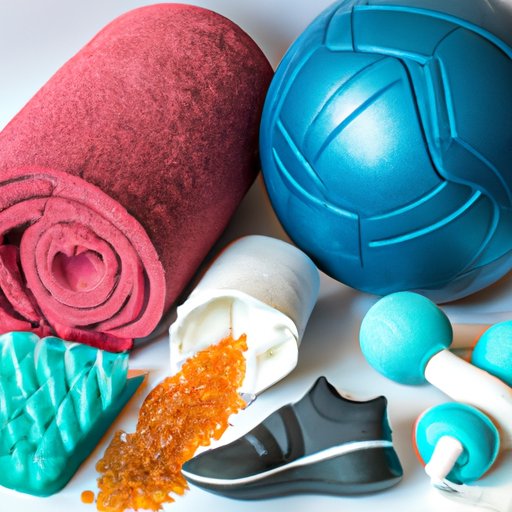Introduction
After a good workout, it’s common to experience some soreness in your muscles. This soreness is often referred to as delayed onset muscle soreness (DOMS). DOMS is caused by microscopic damage to your muscles during physical activity, which leads to inflammation and pain.
Although DOMS is usually temporary, it can still be uncomfortable and interfere with daily activities. Fortunately, there are several treatments that can help reduce the pain of sore muscles. In this article, we will explore what causes DOMS, different treatment options, and tips for avoiding soreness in the future.
Causes of Sore Muscles
When you exercise, you put stress on your muscles. The amount of stress depends on the type of exercise, how hard you worked, and how long you exercised. As your muscles recover from this stress, they become stronger and better able to handle similar stresses in the future.
However, when the stress is too much or too sudden, it can cause microscopic tears in your muscles. These tears trigger inflammation and pain, leading to DOMS. There are several factors that can contribute to this type of muscle strain:
- Overworking muscles: Doing too much too soon can lead to DOMS. If you’re new to exercise, start slowly and gradually increase the intensity and duration of your workouts.
- Not properly warming up: Warming up before exercise helps prepare your muscles for the workout ahead. Try dynamic stretches or a light jog to get your heart rate up and your muscles ready.
- Poor form during exercise: Poor form can put extra stress on your muscles, leading to DOMS. Make sure to use proper form when exercising and don’t push yourself beyond your limits.
Treatment Options
There are several ways to treat sore muscles, including foam rolling, warm baths with Epsom salts, stretching exercises, replenishing fluids, and using an ice pack or cold compress. Let’s take a closer look at each option.
Foam Rolling/Massage Ball
Foam rolling and massage balls are simple tools used to relieve tightness and tension in your muscles. Foam rolling works by applying pressure directly to the area of soreness, which helps break up knots and promote circulation. Massage balls work similarly but are smaller and more focused.
“Foam rolling has been shown to improve range of motion, reduce muscle fatigue, and even improve performance,” says Dr. Mike Koczwara, Physical Therapist and Founder of Fitwell. “It’s an easy and effective way to treat sore muscles.”
To use a foam roller or massage ball, apply direct pressure to the area of soreness for 30-60 seconds. You may need to move the roller or ball around to find the exact spot that needs attention. You can also use circular motions to further massage the area.
Warm Bath with Epsom Salts
A warm bath with Epsom salts is another great way to reduce muscle soreness. The Epsom salts contain magnesium sulfate, which can help reduce inflammation. The warmth of the water helps relax your muscles and promote circulation.
To prepare the bath, add 2-3 cups of Epsom salts to a tub full of warm (not hot) water. Soak in the bath for 20-30 minutes and then rinse off with cool water. You can do this 1-2 times per day to help reduce muscle soreness.
Stretching Exercises
Light stretching can help reduce muscle soreness by promoting circulation and improving flexibility. Start with dynamic stretches, such as arm circles and leg swings, to warm up your muscles. Then move on to static stretches, such as kneeling hip flexor stretch and cobra stretch, to target specific areas of soreness.
“Research suggests that stretching can help reduce DOMS,” says Dr. Koczwara. “It’s important to focus on slow, controlled movements and to hold each stretch for 10-15 seconds.”
Replenishing Fluids
Staying hydrated is essential for recovery after exercise. When you sweat, you lose electrolytes, which are minerals that help regulate bodily functions. Replenishing these electrolytes helps your body recover faster and reduces muscle soreness.
The amount of water you need to drink depends on your size and activity level, but most people should aim to drink 8-10 glasses of water per day. You can also drink sports drinks to replace lost electrolytes.
Ice Pack or Cold Compress
Applying an ice pack or cold compress to the area of soreness can help reduce swelling and inflammation. This is because cold temperatures constrict blood vessels, reducing the flow of blood to the affected area. Ice packs can also numb the area, providing short-term relief.
To use an ice pack or cold compress, wrap a towel around the ice and then place it on the area of soreness for 10-15 minutes. Do not apply the ice directly to your skin, as it can cause frostbite. Repeat this process several times a day as needed.
Conclusion
Sore muscles after a workout can be painful and uncomfortable. Fortunately, there are several treatments that can help reduce the pain of sore muscles. These treatments include foam rolling, warm baths with Epsom salts, stretching exercises, replenishing fluids, and using an ice pack or cold compress.
In addition to these treatments, there are also several things you can do to prevent soreness in the future. Make sure to warm up properly before exercise and maintain proper form during your workout. Additionally, don’t overdo it—start slowly and gradually increase the intensity and duration of your workouts.
(Note: Is this article not meeting your expectations? Do you have knowledge or insights to share? Unlock new opportunities and expand your reach by joining our authors team. Click Registration to join us and share your expertise with our readers.)
